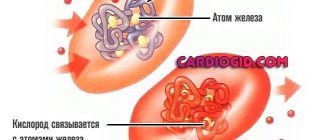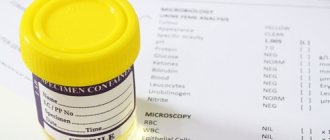General information
Proteinuria is the presence of protein in the urine above the established norm (protein - protein, urine - urine).
Normally, the urine of a healthy person does not contain protein, or traces of it may be present - up to 0.03 g per 1 liter. The appearance of protein in the urine above normal is a pathogenetic factor of progression, which is observed with glomerulonephritis , nephropathy , complications of diabetes , pyelonephritis , lipid nephrosis , urinary tract infections, toxicosis of pregnancy (constant proteinuria), with fever and orthostatic factors (transient) and is usually accompanied by the presence of blood in urine and bacterial infections.
How to take a urine test correctly?
- 1The first morning urine sample is not tested for 24-hour proteinuria; the patient urinates in the toilet.
- 2 Subsequently, all urine is collected into a pre-purchased container (sold in paid laboratories and pharmacies), including the first morning portion for the next day.
- 3 In addition to protein, the study must include a urine test for creatinine to assess the adequacy of the analysis. The amount of creatinine released is proportional to muscle mass and is constant. Men excrete on average 16-26 mg/kg of creatinine per day, women – 12-24 mg/kg/day.
- 4The last urination is carried out exactly one day after the first.
- 5The urine collected in one container is mixed, the total volume of urine is recorded. 30-50 ml of urine is poured into a separate sterile container.
- 6On the container you must make a note about the daily volume of urine, indicate your height and weight.
- 7 Store urine collection containers at temperatures from +2 to +8C.
Pathogenesis
Proteinuria does not have a clinical picture as such, its pathogenesis is not fully understood. The decisive role belongs not to functional factors, but to ultrastructural changes in the nephron , the structural and functional unit of the kidney.
Nephron structure
Urine excretion occurs in three stages:
- filtration;
- reabsorption;
- secretion (includes the formation of primary and secondary urine).
In glomerulonephritis, impaired protein filtration occurs when the basement membranes of the nephron glomeruli are damaged by inducing immune inflammation:
- Fixation occurs on the basement membrane and intramembrane of immune complexes, where the antigen can be exogenous (infectious or non-infectious origin) or endogenous (tissue protein, DNA) - this is immune complex glomerulonephritis .
- Damage to the basement membrane of the nephron glomeruli occurs with antibodies against its glycoprotein antigens - nephrotoxic glomerulonephritis .
Stages of urine formation
With tubular damage, impaired reabsorption and the development of proteinuria, diffuse changes occur and the inability to maintain the necessary filtration pressure in the tubules. In addition, tubular interstitial nephropathy is possible due to xenobiotic damage by foreign toxic substances - heavy metals, drugs, but the mechanisms of kidney damage by many nephrotoxins have not yet been established.
Nephrotoxins and their sites of exposure:
| Glomeruli | Proximal tubules | Distal tubules (collecting ducts) |
|
|
|
Daily value of urine protein
In a healthy person, the urine protein concentration exceeds 50 milligrams.
Strong physical activity leads to proteinuria over 100 mg.
Laboratory tests (nitrogen, sulfosalicylic, pyrogallic) become positive if the presence of protein exceeds 0.033 grams per liter.
The nitric acid test (Robert-Stolnikov) consists of obtaining a protein suspension stained with biuret. Electrophoresis allows the separation of protein types. Proteinuria represents about 20 different types of proteins:
- Immunoglobulins;
- Haptaglobins;
- Ceruloplasmin;
- Siderophilin;
- Postalbumins;
- Prealbumin;
- Albumen.
Types of proteins and consequences of proteinuria
Certain types of proteinuria are detected in different diseases. Thus, in students with an emotional form of nosology, a significant increase in albumin levels is detected.
Transient forms occur in the following pathological conditions:
- Epilepsy;
- Concussion;
- Nervous tension.
Classification
Depending on the amount of protein in the urine, there are:
- Mild proteinuria (detected from 0.15 to 0.5 g of protein per day), which is characteristic of acute post-streptococcal glomerulonephritis, chronic glomerulonephritis, hereditary nephritis, tubulopathy, interstitial nephritis and obstructive uropathy .
- Moderate proteinuria (0.5-2 g per day), which can occur with acute post-streptococcal glomerulonephritis, hereditary nephritis, chronic glomerulonephritis .
- Severe proteinuria (over 2 g per day), which occurs with nephrotic syndrome and amyloidosis .
There are non-pathological and pathological proteinuria (according to Bergstein).
Non-pathological proteinuria as a natural reaction of the body to certain factors occurs:
- orthostatic - the amount of protein in the urine increases when the patient is standing and sharply decreases when the person is lying down;
- febrile – caused by an increase in temperature;
- as well as non-pathological proteinuria, which occurs as a result of heavy physical exertion, increased protein nutrition, administration of protein solutions or blood transfusions.
Pathological proteinuria, depending on structural lesions, is:
- glomerular (glomerular) – occurring with glomerulonephritis, nephrotic syndrome , tumors, drug diseases, congenital diseases or without an established cause;
- tubular (tubular) - caused by hereditary cystinosis (formation of cystine ), Wilson-Konovalov disease , Lowe's syndrome , tubular acidosis, galactosemia, as well as as a result of disorders caused by drug abuse, treatment with antibiotics , penicialamines , heavy metal poisoning, hypervitaminosis D, hypokalemia , interstitial, radiation nephritis, acute tubular necrosis, cystic disease or sarcoidosis .
Which doctors should you contact if you have proteinuria?
- Nephrologist
Test systems are used to determine proteinuria. These are standard strips and protein precipitation with acids - sulfasalicylic or trichloroacetic. Subsequently, the protein concentration is determined using nephelometry or refractometry methods.
The biuret method and the Kjeldahl method are recognized as more accurate. They detect the amount of protein in tissues and fluids using the azotometric method. These methods of protein chemistry and radioimmunoassays make it possible to detect various low-molecular and high-molecular proteins in urine. The following are presented for analysis:
- prealbumin,
- albumin acid glycoprotein,
- beta2-microglobulin,
- alpha 1-antitrypsin,
- alpha lipoprotein,
- siderophyllin,
- ceruloplasmin,
- haptoglobin,
- transferrin,
- a2-macroglobulin,
- gamma globulin.
Causes
The development of proteinuria is based on 4 main factors:
- a change in the permeability of glomeruli (glomeruli of the kidney), causing increased filtration of serum proteins, mainly albumin - up to 60% ( albuminuria ), which leads to glomerular proteinuria ;
- disruption of the process of protein reabsorption in the renal tubular system;
- filtration of low molecular weight proteins and proteins with structural changes that exceed the reabsorption capabilities of the tubules - proteinuria overload ;
- increased level of secretion of uroepithelial mucoproteins and secretory immunoglobulin A , for example, caused by inflammation of the urinary tract.
Risk factors for proteinuria
Some people are more likely to develop proteinuria. Common risk factors include:
- Age. Adults 65 and older are more susceptible to dehydration and kidney problems. Pregnant people over 40 have a greater risk of preeclampsia.
- High blood pressure. People with high blood pressure have a higher risk of developing diabetes and kidney disease.
- Diabetes. Diabetes is the most common cause of CKD. It is also associated with preeclampsia and glomerulonephritis.
- Family history. You are more likely to develop proteinuria if you have a history of kidney disease or preeclampsia.
- Certain nationalities. People of African American, Hispanic, Native American, and Asian descent are at greater risk of kidney problems.
- Overweight or obese. High blood pressure, diabetes and preeclampsia are associated with being overweight or obese.
Symptoms
An increase in the amount of proteins in the urine does not have its own clinical manifestations; the symptoms of the underlying disease, which led to pathological changes and impaired renal function, usually dominate.
Most often, proteinuria is a manifestation of nephrotic syndrome , which is combined with swelling, hypoproteinemia and hyperlipidemia . In addition, loss of protein in the urine can lead to fatigue, decreased immunity , dizziness, and drowsiness.
The main causes of increased urine protein
The following etiological forms of proteinuria are distinguished:
- Cardiac (congestive) develops with heart failure;
- Renal (true) appears when there is a change in glomerular permeability;
- False is characterized by an increase in urine protein directly in the urinary tract in the presence of inflammation;
- Lordotic (orthostatic) is provoked by lumbar lordosis, causing venous stagnation of the pelvis;
- Paroxysmal (epileptic) accompanies an attack of the disease;
- Palpation is formed by feeling the lower back with your fingers;
- Sports – for people engaged in active physical labor;
- Transient (muscular) proteinuria is observed with strong muscle loads.
There are a number of dangerous diseases in which pathological protein appears in urine: hemolytic anemia, paraproteins, liver disease.
Tests and diagnostics
To detect proteinuria, a qualitative and quantitative assessment of urine samples is needed - diagnostic test strips are used and the following is carried out:
- Heller ring test;
- research using the Brandberg–Roberts–Stolnikov method;
- turbidimetry;
- colorimetry.
If the amount of proteins exceeds the norm, then a further examination is carried out to diagnose the location and type of pathology, for example, glomerulonephritis or tubulointerstitial nephritis.
Daily proteinuria and total protein in urine
To determine proteinuria, you need to provide daily urine. The material should be collected within 24 hours and stored in a clean container, in a cool, dry place, and first the first morning urine should be poured into the toilet, and all subsequently collected urine of the next day should be submitted for examination.
Before donating urine to determine total protein, you must abstain from drinking alcohol for 24 hours and carry out thorough hygiene procedures for the genital area. Moreover, mid-morning urine is taken for analysis (the first and last 15-20 ml are not taken). The norm for a healthy person is 0-0.033 g/l.
One of the functional indicators of kidney disease is creatinuria . Creatine normally excreted in the urine; it is usually found in pregnant, breastfeeding women and children as a physiological reaction. During diagnosis, the protein/creatinine ratio (albumin-creatinine ratio) and excretion level are important - indicators of glomerular filtration rate, important for the prognosis of chronic kidney diseases and diabetic nephropathy.
Treatment of proteinuria with traditional methods
Treatment of proteinuria may require a sufficient amount of time, and conservative therapy prescribed by a doctor is used in courses. Together with medications or in between them, the use of folk remedies is allowed, which you should definitely notify your doctor about. Discuss with him which of the following recipes is suitable in your particular case:
- parsley seeds - 1 tsp. grind the seeds in a coffee grinder or mortar until a powder forms, add a glass of boiling water and leave for several hours; take small sips throughout the day;
- birch buds - 2 tbsp. place the kidneys in a thermos and brew with a glass of boiling water; after 1.5 hours, strain; drink 50 ml three times a day;
- corn - 4 tbsp. pour 500 ml of boiling water over corn grains and simmer over low heat until the grains soften; Strain the broth and drink throughout the day, prepare a new one the next morning;
- oats - 5 tbsp. pour oat grains (not flakes!) into a liter of water and boil until softened; drink small portions throughout the day;
- lingonberries - pour 20 grams of crushed lingonberry leaves with a glass of boiling water, leave for 20-30 minutes, strain; take 1 tbsp. three times a day;
- bearberry – 1 tbsp. Grind the bearberry, brew in three glasses of water and simmer over low heat until the broth has reduced by three times; strain; drink small portions throughout the day.
Proteinuria during pregnancy
An increase in the amount of daily proteinuria in pregnant women to 30 mg is the norm, because changes occur in the body - a shift in hormonal levels, an increase in blood volume, an increase in the load on the filtration system, especially in the later stages. When this figure fluctuates within 300 mg, then we talk about microalbuminuria , which can occur:
- with increased anxiety, frequent stress;
- enhanced protein nutrition;
- under conditions of physical activity and stress;
- with excess fluid consumption;
- as a result of the occurrence of inflammatory processes in the urinary tract, for example, with cystitis .
Protein loss can also be considered a sign of gestosis - a complication of pregnancy, which is accompanied by increased blood pressure, edema, cramps, bleeding , and the development of eclampsia . In this regard, pregnant women should contact a specialist at the first symptoms and undergo all tests regularly.
What are the dangers of proteinuria?
Detection of protein molecules in urine becomes, first of all, a way to clarify any kidney disease. But low- and high-molecular-weight albumins and proteins themselves, entering in excess quantities into the tubular, pyelocaliceal renal systems and further into the urinary canals, are not “neutral” for the epithelium of these structures. They have a negative, nephrotoxic effect.
Thus, increased amounts of albumin enhance the inflammatory process, destroy the epithelial cells of the proximal renal tubules, and contribute to their spasm. Another protein, transferrin, increases the formation of oxygen radicals and increases the severity of inflammatory phenomena. The higher the level of pathological proteinuria, the more intense its negative impact on the renal interstitium. It has been proven that it is the high content of protein molecules in primary urine that becomes the leading risk factor for the formation of renal failure in most kidney diseases, especially in chronic nephropathies. In addition, the same factor, predominantly microalbuminuria, is a catalyst for the development of complications from the heart and blood vessels.
Excess protein in a general urine test can indicate the possibility of kidney disease
Treatment tactics
The tactics for managing a patient with proteinuria directly depend on the cause, the risk of an unfavorable outcome, and the prognosis, which determines the need for dynamic monitoring by a therapist or nephrologist.
Video Photo Tables
Prevention
Unfortunately, there are no specific recommendations for the prevention of proteinuria. The only thing that can be said with certainty is that you need to see a specialist. Prompt assessment, diagnosis, treatment and long-term monitoring of patients' health can significantly prevent potential progression of the underlying disease process.
Limiting protein intake is often required. However, patients should receive adequate daily protein intake depending on their age. A positive response to proteinuria is an indicator of a good prognosis. This reaction is also a predictor of high survival, stabilization of renal function, as well as subsequent changes in glomerular filtration rate.
Proteinuria and nephrotic syndrome
L.Yu. MILOVANOVA, Candidate of Medical Sciences, Senior Researcher, Department of Nephrology, Research Center MMA named after. THEM. Sechenov
L.V. LYSENKO, Doctor of Medical Sciences, Professor of the Department of Therapy and Occupational Diseases of the MMA named after. THEM. Sechenov
Excretion of protein in urine exceeding normal values (30-50 mg/day) is called proteinuria and is usually a sign of kidney damage. There are several types of proteinuria. Glomerular proteinuria develops due to increased permeability of the glomerular filter to proteins. Tubular proteinuria is the result of damage to the proximal tubules, which normally reabsorb low-molecular-weight proteins that pass through the glomerular filter. A characteristic sign of tubular proteinuria is the predominance of β2-microglobulinemia over albumin and the absence of high molecular weight proteins. Hyperproteinemic proteinuria is “overflow” proteinuria, which occurs due to an excess of any protein in the blood, freely passing through the little-changed glomerular filter - light chains of immunoglobulins, lysozyme, β2-microglobulin, retinol-binding protein, hemoglobin, myoglobin in an amount exceeding the capacity of the tubules to its reabsorption.
Tubular proteinuria almost never exceeds 2 g/day and does not lead to nephrotic syndrome, as does hyperproteinemic proteinuria.
Functional proteinuria, the exact mechanisms of development of which are not well established, include orthostatic proteinuria, tension proteinuria, febrile proteinuria.
Microalbuminuria is urinary excretion of albumin not exceeding 300 mg/day. Microalbuminuria is considered as a marker of generalized endothelial dysfunction, which indicates a significant deterioration of not only the renal prognosis, but also an increased risk of cardiovascular complications, including in persons who do not suffer from disorders of carbohydrate metabolism. In clinical practice, to determine protein in urine, samples with the addition of sulfasalicylic or trichloroacetic acid are used, followed by niphelometry or refractometry, as well as using the more accurate biuret method. In recent years, the method of testing protein in urine using test strips has been widely used. More subtle methods of protein chemistry (immunoelectrophoresis, laser nephelometry, immunoblotting, immunofixation, etc.) can identify various protein fractions in urine - low molecular weight (β2-microglobulins, light chains of immunoglobulins, etc.) and high molecular weight (β2-macroglobulin , ?-globulin).
Nephrotic syndrome is one of the most characteristic and serious manifestations of acute and especially chronic kidney diseases. The top six causes, accounting for more than 90% of all cases of nephrotic syndrome, are glomerulonephritis (minimal change disease, focal segmental glomerulosclerosis, membranous nephropathy, mesangiocapillary glomerulonephritis), diabetic glomerulosclerosis, and amyloidosis. The basis of major proteinuria leading to nephrotic syndrome can only be glomerular proteinuria, when, with any damage to the glomerular filter, the basement membrane or filtration gaps between the podocyte stalks are structurally damaged and/or lose their negative charge.
Components of nephrotic syndrome:
1. Mandatory
» “large” proteinuria (more than 3 g/day in adults, more than 50 mg/kg/day in children) hypoalbuminemia (less than 30 g/l) edema
2. Optional
» hypercholesterolemia, dyslipoproteinemia, activation of coagulation factors (hyperfibrinogenemia), disturbance of phosphorus-calcium metabolism, hypocalciuria, osteoporosis) immunosuppression (including a decrease in IgG immunoglobulin, phagocytic function of monocytes and neutrophils).
Arterial hypertension and hematuria are not considered manifestations of nephrotic syndrome.
Hypoalbuminemia is a direct consequence of proteinuria; The level of albumin is lower, the greater its excretion in urine. Other causes of hypoalbuminemia are the breakdown of reabsorbed albumin in the proximal tubules and insufficient increase in albumin synthesis in the liver.
The reasons for the formation of edema in nephrotic syndrome are not entirely clear. The most common hypovolemic hypothesis. With hypoalbuminemia, the oncotic pressure of plasma decreases, which leads to the release of water from the vessels into the interstitium. In response to a decrease in circulating blood volume (CBV), the renin-angiotensin system is activated, sympathetic tone increases, and the secretion of pituitary antidiuretic hormone increases, while at the same time the secretion of atrial natriuretic hormone decreases. All this leads to sodium and water retention, which continues to move into the interstitial tissue space. However, it is not entirely clear why edema develops in those patients whose blood volume is not reduced, but even increased, and the renin-angiotensin system is suppressed? Apparently, in such cases, the formation of edema is caused by primary renal retention of salt and water.
Hyperlipidemia is believed to develop due to the liver increasing its production of lipoproteins in response to a decrease in plasma oncotic pressure, as well as due to the loss in urine of proteins that regulate lipoprotein metabolism. At the same time, the level of total cholesterol and low-density lipoproteins (LDL) is increased in most patients, and very low-density lipoproteins and triglycerides are increased in the most severe cases. Hyperlipoproteinemia in patients with nephrotic syndrome contributes to the development of atherosclerosis and the progression of chronic renal failure.
Increased blood clotting in nephrotic syndrome has several causes: loss of antithrombin III, proteins C and S in the urine, increased synthesis of fibrinogen in the liver, weakened fibrinolysis and increased platelet aggregation. Clinically, these disorders are manifested by thrombosis of peripheral vessels and renal veins, pulmonary embolism. Symptoms of acute renal vein thrombosis: sudden pain in the lower back and abdomen, microhematuria, in men, left-sided varicocele (the vein of the left testicle flows into the vena cava), a sharp increase in proteinuria and a drop in glomerular filtration rate (GFR). Chronic renal vein thrombosis is usually asymptomatic. Renal vein thrombosis develops especially often (up to 40% of cases) in patients with nephrotic syndrome with membranous nephropathy, mesangiocapillary glomerulonephritis and amyloidosis.
Microcytic hypochromic anemia develops due to loss of transferrin. Protein deficiency is observed - the loss of serum proteins that carry vitamin D leads to vitamin D deficiency with hypocalcemia and secondary hyperparathyroidism, the loss of transthyretin leads to a decrease in the level of T4, Ig - to a decrease in resistance to infections. The pharmacokinetics of drugs that bind to plasma proteins may also change unpredictably.
Classification
I. Primary nephrotic syndrome
1. Primary (Bright) glomerulonephritis (the frequency among the causes of primary nephrotic syndrome in adults is indicated in parentheses)
» minimal change nephropathy (up to 15%) focal segmental glomerulosclerosis (20-25%) membranous nephropathy (25-30%) mesangiocapillary glomerulonephritis (5%) other forms of glomerulonephritis (including fibrillary, collapsing and immunotactoid glomerulopathy) (15- thirty%).
II. Secondary nephrotic syndrome
1. For systemic diseases:
» diabetes mellitus, amyloidosis, systemic lupus erythematosus, hemorrhagic vasculitis, paraproteinemia (multiple myeloma, light chain disease), mixed cryoglobulinemia, subacute infective endocarditis.
2. For infectious diseases:
» bacterial (streptococcal infection, syphilis, tuberculosis, sepsis) viral (hepatitis B and C, HIV) parasitic invasions (malaria, toxoplasmosis, schistosomiasis).
3. As a result of the action of drugs:
» preparations of gold, bismuth, mercurypenicillamine, lithium preparations, non-steroidal anti-inflammatory drugs, anticonvulsants, antibiotics and anti-tuberculosis drugs, anti-gout drugs, vaccines and serums.
4. For tumors:
» Lymphogranulomatosis and non-Hodgkin's lymphomas (associated with minimal change nephropathy and secondary amyloidosis) solid tumors (associated with membranous nephropathy and secondary amyloidosis).
III. Hereditary diseases
» congenital nephrotic syndrome of the Finnish type, familial nephrotic syndrome, hereditary onychoarthrosis, sickle cell anemia, Fabripartial lipodystrophy.
IV. Other reasons
» renal thrombosis, venous morbid obesity, pregnancy, chronic heart failure, chronic transplantation nephropathy.
Clinical picture
It is important to note that the primary disorder in nephrotic syndrome is high proteinuria, which occurs due to increased permeability of the glomerular filter; all other manifestations of nephrotic syndrome are a consequence of proteinuria, although they can be present with moderate proteinuria and absent when proteinuria is very high.
Edema in patients with nephrotic syndrome often reaches the level of anasarca. Not only peripheral, but also cavitary edema (hydrothorax, ascites, hydropericardium) is observed.
Due to long-standing dyslipoproteinemia in patients with nephrotic syndrome, the progression of atherosclerosis may accelerate with the formation of cardiovascular complications. In addition, lipid metabolism disorders directly contribute to the progression of kidney damage. Lipid metabolism disorders are often especially pronounced in persistent nephrotic syndrome and in patients receiving corticosteroids. Disorders of phosphorus-calcium metabolism in children with nephrotic syndrome often lead to tetany, and osteomalacia is possible in adults.
Sometimes nephrotic syndrome, especially with mesangioproliferative glomerulonephritis, is accompanied by hematuria. In the presence of cellular or granular casts in the urinary sediment, it is necessary to exclude lupus nephritis and glomerulonephritis, for example, with essential mixed cryoglobulinemia, infective endocarditis and hemorrhagic vasculitis.
In adults, a kidney biopsy is necessary for diagnosis and treatment. Children are not usually given a biopsy because... In the vast majority of cases, their nephrotic syndrome is caused by minimal change disease.
Complications of nephrotic syndrome
1. Infectious complications (pneumonia, pleural empyema, peritonitis, skin infections, urinary tract infections, sepsis) in the prebacterial era were one of the main causes of death in patients with nephrotic syndrome. The entry gates for infection are often skin cracks and ulcers in the area of edema. Treatment with immunosuppressants also predisposes patients with nephrotic syndrome to infectious complications.
2. Thrombotic and thromboembolic complications include peripheral phlebothrombosis, pulmonary embolism, thrombosis of the renal artery with the development of infarctions of its parenchyma.
3. Complications caused by the progression of atherosclerosis: the development of coronary heart disease, including acute myocardial infarction.
4. Cerebral edema in nephrotic syndrome is rare, usually in the presence of anasarca. The patient is characterized by lethargy and lethargy, and in subsequent stages - coma. In addition, with severe edematous syndrome, retinal edema often occurs, which is reversible with an increase in albumin in the blood serum.
5. Nephrotic crisis is a special variant of hypovolemic shock, which is characterized by pronounced overproduction of kinins, causing the appearance of anorexia, vomiting, abdominal pain, painful migratory (“erysipelas-like”) erythema (usually in the abdomen and lower extremities). Arterial hypotension and collapse develop. One of the causes of nephrotic crisis is inadequate prescription of diuretics. Treatment involves replenishing blood volume. An approximate determination of the state of circulating blood volume in patients with nephrotic syndrome is possible based on the analysis of clinical data (Table)
6. Acute renal failure is a relatively rare complication of nephrotic syndrome. Caused by renal vein thrombosis, hypovolemia, the use of nonsteroidal anti-inflammatory drugs and radiocontrast agents, as well as sepsis.
Laboratory research
In addition to hypoalbuminemia and hypoproteinemia, significant dysproteinemia is found in nephrotic syndrome: the content of β2-globulins is almost always increased, the content of β-globulins is decreased (in systemic lupus erythematosus - hyper-β-globulinemia).
An important sign of nephrotic syndrome is dyslipoproteinemia, characterized by hypertriglyceridemia, an increase in total cholesterol due to LDL cholesterol.
Nephrotic syndrome is considered among acquired immunodeficiencies. Violations are recorded mainly in the humoral immune system: the production of antibodies is significantly reduced, and a significant decrease in the content of IgG in the blood serum is often observed.
Treatment
Of course, the most progressive is the etiological principle of treatment of nephrotic syndrome, therefore, clarification of its etiology is of great practical importance. Elimination of the causative factor (elimination of the antigen) - fight against infection, radical removal of the tumor - can in itself cause the reverse development of nephrotic syndrome. In cases where the etiological principle of treatment of nephrotic syndrome is impossible, general measures are used, which in some cases make it possible to relieve most of its symptoms (Fig.)
The severity of the nephroprotective effect of most drugs (angiotensin-converting enzyme (ACE) inhibitors, angiotensin II receptor blockers, statins, calcium channel blockers) is due precisely to their antiproteinuric effect. Targeting proteinuric remodeling of the interstitium is one of the most effective ways to inhibit the progression of chronic kidney disease.
Isolating the hypovolemic variant of nephrotic syndrome is important from the point of view of indications and contraindications for the use of diuretics. In the hypovolemic version of nephrotic syndrome, these drugs significantly worsen hypovolemia and provoke a nephrotic crisis. Hypoalbuminemia causes a decrease in the intensity of transport of many substances, including drugs, such as furosemide.
The search continues for saluretics that are not transported by plasma proteins and are more effective in hypoproteinemic conditions, including nephrotic syndrome. In order to enhance the effect of diuretics in cases of edema refractory to diuretics, parenteral administration of various protein solutions (albumin, fresh frozen plasma, etc.) can be used.
Forecast
The prognosis of patients with nephrotic syndrome is determined by the risk of developing various complications. Some of them, in particular nephrotic crisis, may be iatrogenic. When assessing the prognosis of nephrotic syndrome, other clinical criteria should also be taken into account - markers of poor prognosis in nephrotic syndrome:
» Persistent course, especially with massive proteinuria Combination with arterial hypertension Rapid onset of signs of renal failure.
The dynamics of protein excretion in urine is important when prescribing pathogenetic therapy. A relatively rapid decrease in proteinuria is considered a favorable prognostic sign.
Timely diagnosis and impact on proteinuria can in most cases prevent or at least reduce the rate of progression of most chronic nephropathies.
general description
Proteinuria is the excretion of protein in the urine in quantities exceeding normal values.
This is the most common sign of kidney damage. Normally, no more than 50 mg of protein, consisting of filtered plasma low-molecular proteins, is excreted into the urine per day. Causes:
- Damage to the renal tubules (interstitial nephritis, tubulopathies) leads to impaired reabsorption of filtered protein and its appearance in the urine.
- Hemodynamic factors - the speed and volume of capillary blood flow, the balance of hydrostatic and oncotic pressure are also important for the appearance of proteinuria. The permeability of the capillary wall increases, contributing to proteinuria, both with a decrease in the speed of blood flow in the capillaries, and with glomerular hyperperfusion and intraglomerular hypertension. The possible role of hemodynamic changes should be taken into account when assessing proteinuria, especially transient proteinuria, and in patients with circulatory failure.









